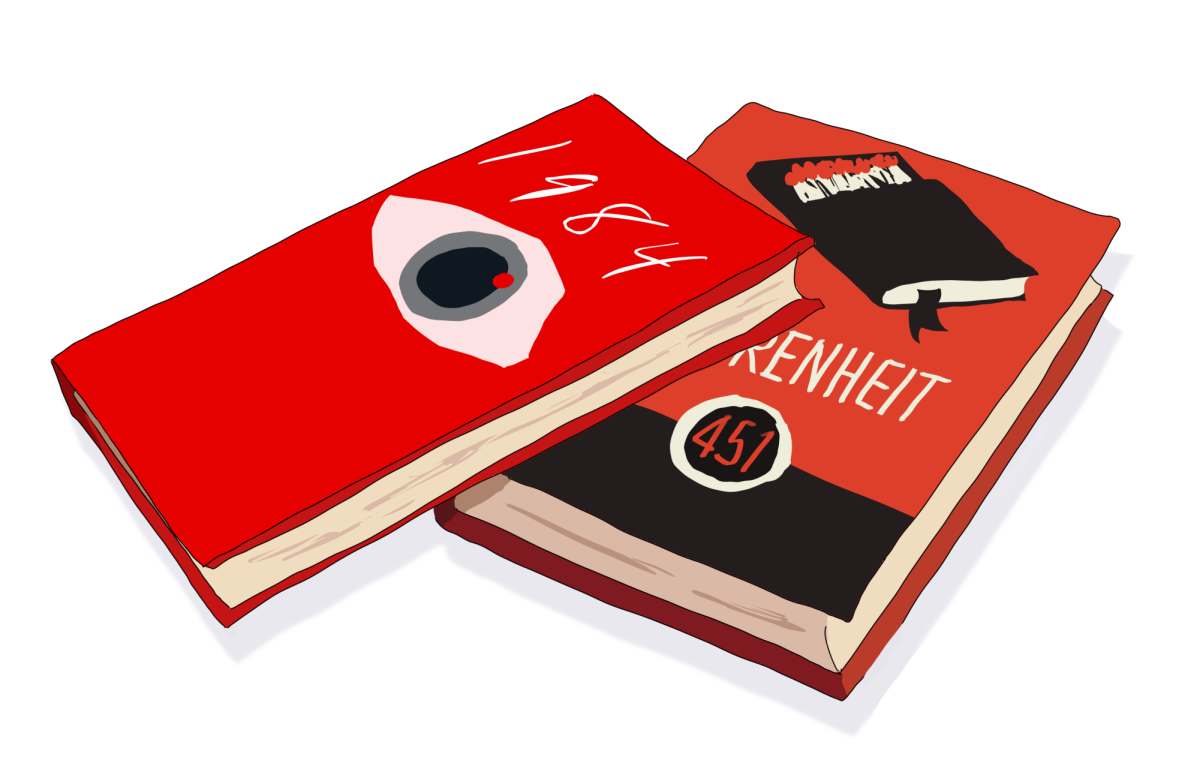As Junior Sivan Kuo sits in her Freshman Literature classroom, her ears perk up and her eyes stare in disbelief — a book written in 1953 has seemingly predicted the current technological landscape to a tee.
“Fahrenheit 451” by Ray Bradbury describes a dystopian society where books are banned and critical thinking is discouraged through advanced technology. Kuo notes how many of these advancements, like screens placed on walls and speakers kept in people’s ears, strongly parallel current products. However, as an avid reader, Kuo could not imagine the bookless society the novel presented.
“‘Fahrenheit 451’ made me think about what life would be like without books, and how much we need knowledge,” Kuo said. “Knowledge is valuable so you have common sense, can think for yourself, and be open to new possibilities. Without it, it creates a society that is censored with the ability to think taken away.”
Junior Eesha Sah also read “Fahrenheit 451” in her freshman year and recalls how the book presented a realistic depiction of life under a totalitarian regime. She adds how one of the defining themes of “Fahrenheit 451” is confusion as a result of lack of thinking and censorship. She thinks this confusion can also be seen in present-day society for similar reasons.
“People are confused about their belongings and their purpose in life,” Sah said. “It’s because they have so many barriers and restraints as to what they can do, they don’t have the freedom to make their own choices.”
According to English teacher Mark Carpenter, the dystopian genre showcases societies where unchecked problems have been taken to logical horrible conclusions. They explain that dystopian novels, unlike other genres, can be used to reflect a society’s fears and anxieties. At their core, these books show a possible future that should be avoided.
In “Fahrenheit 451,” Bradbury explored his fears around the increasing prevalence of technology as advancements were made. Sah adds how dystopian novels tend to be darker than others in the curriculum — novels like “Fahrenheit 451” often don’t have the happy endings students are used to.
Another dystopian novel, “1984” by George Orwell, is taught in the World Studies course and explores life under an oppressive regime with constant surveillance and propaganda. When Sah took this course and read “1984,” she recalls how the portrayal of oppression and lack of individuality heavily contrasted her current life in a democratic society where she is free to be herself.
“We should feel grateful for what we have,” Sah said. “I’m really glad to be in a place where there’s freedom, where we have a say in the government and what happens in our country.”
Kuo, who also read the book, agrees, asserting that Sah’s introspective reaction is exactly why the book is taught. She believes the themes of censorship and totalitarianism provide a perfect environment for students to reflect on their lives and education.
“It’s taught in this curriculum to make students think about their own education and to value thinking for yourself and learning new knowledge,” Kuo said. “If you don’t value knowledge you’re just going through actions without understanding why you’re doing it just because someone told you.”
Carpenter adds there’s another educational aspect of “1984” — in World Studies, the novel is used to complement students’ concurrent learning about the historical rises of dictatorships and the Cold War. “1984” was written during World War II to explore Orwell’s anxiety around the arms race between the U.S. and the Soviet Union. While teaching “1984” Carpenter works with their history co-teacher to explain the book’s historical context while they focus on teaching the literary aspects.
“I want students to think if this novel offers any possibility of hope,” Carpenter said. “If there is a map to be found in this book of how to avoid these outcomes. Is it just a warning? Is it a prophecy of doom? Is it still relevant today? Do we see our society closer to or further from these outcomes than when Orwell wrote it? I want to lead students in discussions, hear their questions, see what they make of it, and help them find meaning.”
Carpenter understands that student reception to books is always mixed. For “1984,” they recount how student responses range from high praise to outright refusal to read it. They acknowledge that for some students, “1984’s” wordiness can be boring, but they hope that regardless of students’ personal opinions, the novel improves students’ critical thinking and reading analysis skills.
“I hope that having read or been exposed to a book and having engaged in a discussion of any book, students are better able to develop their own sense of what they like and don’t like, and be able to articulate why,” Carpenter said. “I still want students to be able to think about some of the issues that Orwell brings up in there — to be able to think about the issues any author brings up in their text and be able to articulate what questions are raised, what ideas are present in this book, be able to critique what works and what doesn’t.”










